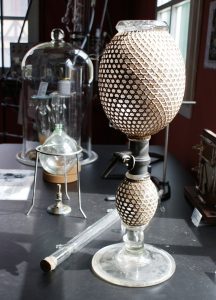Duranglas: Siphon bottle - German/German

2011 was the "International Year of Chemistry". To mark this occasion, the "Liebig Table" was newly prepared, with which the Glass Museum pays tribute to one of the most outstanding chemists of the 19th century: Justus von Liebig. For him, chemistry meant first and foremost improving people's living conditions. Among other things, he invented the precursor of the stock cube - better known as "Liebig's meat extract" -, baking powder and mineral fertiliser. In chemistry, Liebig introduced the epoch-making use of the glass "five-ball apparatus" to determine carbon and hydrogen in plants.
Less well known is our exhibit: the mineral water siphon. Invented by a Mr Briet, the apparatus for preparing carbonated water using sodium bicarbonate and tartaric acid was recommended by Liebig for practical application in everyday domestic use.
An interesting feature of the mineral water siphon bottle is the brown basketwork that encloses both the glass lower part and the glass upper part. Justus von Liebig had attached it as protection because he thought the bubbling carbonic acid gases could cause the glass to burst. At that time, simple soda-lime glasses were still used in chemistry, and they shattered very easily. This only changed when Otto Schott invented borosilicate glass, which is resistant to temperature changes and is also known as Duran glass or, as in the USA, Pyrex glass, around 1890.
When Liebig could no longer meet the demand for glass apparatus himself, he encouraged the Thuringian glassblowers to produce glassware for the laboratory sector instead of knick-knacks. Until the Second World War, the Thuringian glassblowers were leaders in the laboratory glassware industry. After the war, around 1948, many of them settled in Wertheim and laid the foundations for the Wertheim special glass industry that still exists today. The others went to Mainz and rebuilt the Schott works.
Pyrex Glass: Gasogene - English

2011 was the International year of chemistry. And for this occasion we reconstructed the "Liebig Table," and with it, paid tribute to the leading chemist of the 19th-century: Justus von Liebig. For him the main purpose of chemistry was to improve people's lives. This is how he came to discover, among other things, the stock cube, better known here as "Liebig's meat extract." He also discovered baking powder, and mineral fertiliser. Liebig introduced the epoch-making glass potassium apparatus to chemistry that is used to analyse carbon and hydrogen in plants.
Our exhibit, the gasogene is less well known. This piece of apparatus was invented by a Herr Briet to create carbonated water using sodium bicarbonate and tartaric acid, which Liebig recommended for everyday use in the household.
The brown basketwork around the gasogene is interesting. Justus von Liebig added this as a protective layer because he thought that the bubbling carbon gases could cause the glass to shatter. At the time simple chalk soda glass, which shattered very easily, was used in chemistry. This wasn't changed until Otto Schott invented temperature-change resistant glass in around 1890, known as borosilicate glass, or Duranglass, or as Pyrex in England and the USA.
When Liebig could no longer meet the needs for glass apparatus on his own, he inspired the Thuringian glassblowers to produce laboratory glass instead of porcelain figures. And up until the Second World War the Thuringian glassblowers were leaders in the laboratory industry. After the war in around 1948, many of them settled in Wertheim and laid the foundation stone for the Wertheim specialist glass industry that still exists today. The others went to Mainz and re-established the Schott Factory.